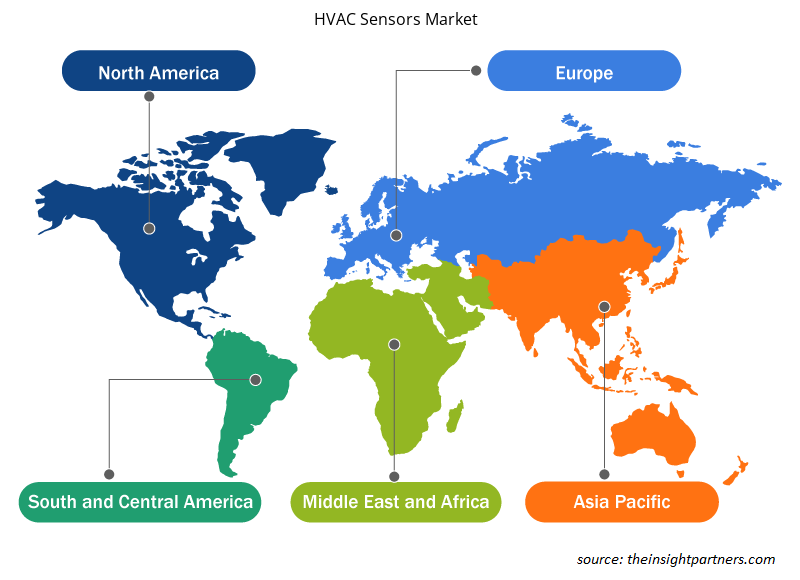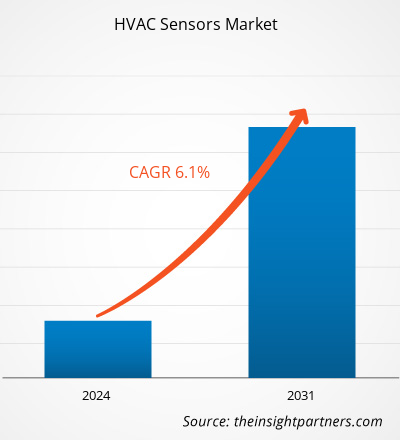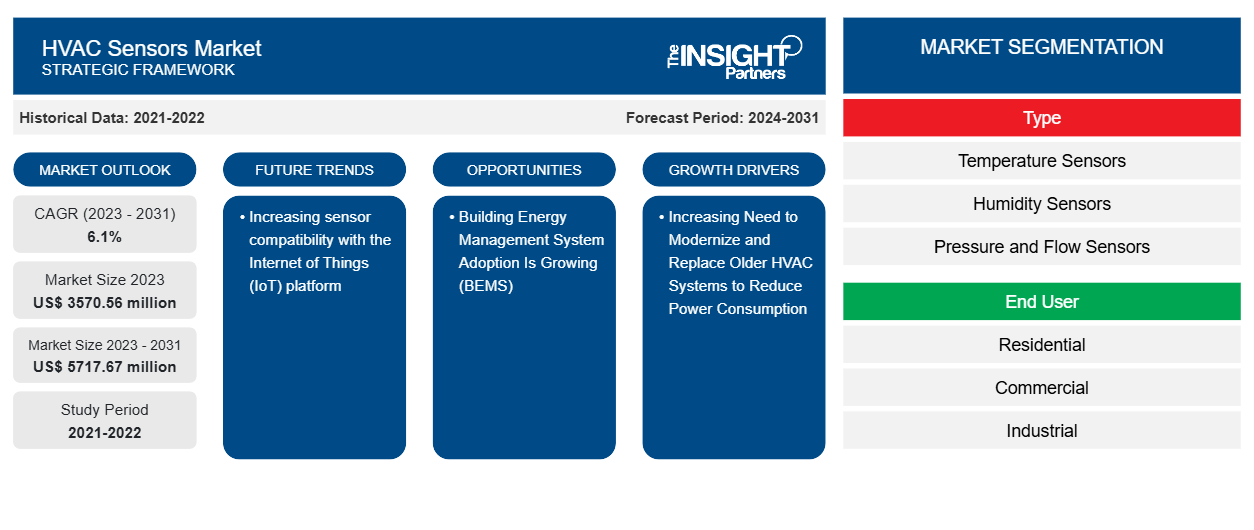من المتوقع أن يصل حجم سوق أجهزة استشعار التدفئة والتهوية وتكييف الهواء إلى 5717.67 مليون دولار أمريكي بحلول عام 2031 من 3570.56 مليون دولار أمريكي في عام 2023. ومن المتوقع أن يسجل السوق معدل نمو سنوي مركب بنسبة 6.1٪ في الفترة 2023-2031.
من المرجح أن يظل التوافق المتزايد بين أجهزة الاستشعار ومنصة إنترنت الأشياء (IoT) أحد الاتجاهات الرئيسية في سوق أجهزة استشعار التدفئة والتهوية وتكييف الهواء.
تحليل سوق أجهزة استشعار التدفئة والتهوية وتكييف الهواء
تم استخدام سوق أجهزة استشعار التدفئة والتهوية وتكييف الهواء من قبل العديد من الصناعات، مثل الصناعات التجارية والسكنية والسيارات وغيرها. في الوقت الحاضر، هناك منافسة شرسة في عالم الأعمال لأن المنظمات الرائدة يجب أن تعطي الأولوية للحفاظ على البيئة والإنتاجية والجودة والسلامة. على مدى السنوات القليلة الماضية، تم استخدام أنظمة التدفئة والتهوية وتكييف الهواء على نطاق واسع في العديد من البرامج في جميع أنحاء العالم. تجد العديد من أجهزة الاستشعار، بما في ذلك أجهزة استشعار الضغط ودرجة الحرارة، من بين أمور أخرى، استخدامًا يجعلها ممكنة. توفر أنظمة التدفئة والتهوية وتكييف الهواء جودة هواء جيدة وراحة حرارية لكل من التصميمات الداخلية للسيارات والغرف. تُستخدم أجهزة استشعار التدفئة والتهوية وتكييف الهواء لتلبية احتياجات مختلف المستخدمين النهائيين الذين يهتمون بكفاءة الطاقة. فهي تساعد في توفير مساحات داخلية يتم صيانتها بشكل صحيح مع انخفاض استخدام الطاقة.
نظرة عامة على سوق أجهزة استشعار التدفئة والتهوية وتكييف الهواء
تُستخدم أنظمة التدفئة والتهوية وتكييف الهواء بشكل متكرر للحفاظ على الطاقة والتحكم فيها وبالتالي تقليل استخدامها. يتم تضمين جهاز صوتي يحاكي حالة حقيقية، مثل درجة الحرارة أو العالم المستهدف، في التردد. يساعد النوع الأكثر أهمية من مستشعرات التدفئة والتهوية وتكييف الهواء في الحفاظ على درجة الحرارة المناسبة وتعديل درجة الحرارة المطلوبة من خلال التمييز بين درجة حرارة المدخلات ودرجة حرارة المبنى أو الغرفة. بالنسبة للمستخدمين النهائيين بما في ذلك المباني الصناعية والسكنية والتجارية ، يمكن لمستشعرات التدفئة والتهوية وتكييف الهواء إدارة ومراقبة عمليات مختلفة مثل ضغط الهواء ودرجة الحرارة والجودة. ونتيجة لذلك، أصبحت مستشعرات التدفئة والتهوية وتكييف الهواء شائعة بشكل متزايد بسبب ضرورة توفير الطاقة.
قم بتخصيص هذا التقرير ليناسب متطلباتك
ستحصل على تخصيص لأي تقرير - مجانًا - بما في ذلك أجزاء من هذا التقرير، أو تحليل على مستوى الدولة، وحزمة بيانات Excel، بالإضافة إلى الاستفادة من العروض والخصومات الرائعة للشركات الناشئة والجامعات
-
احصل على أهم اتجاهات السوق الرئيسية لهذا التقرير.ستتضمن هذه العينة المجانية تحليلاً للبيانات، بدءًا من اتجاهات السوق وحتى التقديرات والتوقعات.
محركات وفرص سوق أجهزة استشعار التدفئة والتهوية وتكييف الهواء
الحاجة المتزايدة إلى تحديث واستبدال أنظمة التدفئة والتهوية وتكييف الهواء القديمة لتقليل استهلاك الطاقة
تقدر المنتدى الاقتصادي العالمي أن المباني مسؤولة عن أكثر من 40٪ من انبعاثات ثاني أكسيد الكربون المرتبطة بالطاقة ونحو ثلث استهلاك الطاقة العالمي. ووفقًا لمجلس المباني الخضراء العالمي، فإن حوالي ثلث هذه الانبعاثات ناتجة عن الطاقة اللازمة لعمليات المبنى، والتي تشمل التدفئة والتبريد وتشغيل الهيكل. ووفقًا لشركة Iota Communications، ينفق متوسط مبنى المكاتب حوالي 30 ألف دولار سنويًا على الكهرباء. في الهيكل التجاري، تستخدم أنظمة التدفئة والتهوية وتكييف الهواء غالبًا معظم الطاقة. ووفقًا لتقديرات وزارة الطاقة الأمريكية، تمثل أنظمة التدفئة والتهوية وتكييف الهواء عادةً 35٪ من استخدام الطاقة في المبنى. زادت الحاجة إلى أنظمة التدفئة والتهوية وتكييف الهواء ذات خصائص ترشيح الهواء أثناء الوباء. تخدم أنظمة التهوية المحدثة غرضًا صحيًا عامًا حاسمًا من خلال ترشيح الهواء وخفض الملوثات المحمولة جوًا، مثل الجسيمات التي تحتوي على فيروسات.
تزايد استخدام نظام إدارة الطاقة في المباني (BEMS)
لا يمكن للمباني أن تعمل بدون أنظمة التدفئة والتهوية وتكييف الهواء على الرغم من تكاليفها الباهظة. تقدر وزارة تغير المناخ والطاقة والبيئة والمياه الأسترالية أن نظام التدفئة والتهوية وتكييف الهواء المتوسط يستخدم حوالي 40٪ من إجمالي استهلاك الطاقة في المبنى و70٪ من استخدامه الأساسي للطاقة. تراقب الأنظمة الآلية القائمة على الكمبيوتر والمعروفة باسم أنظمة إدارة طاقة المباني (BEMS) وتنظم كل نظام متعلق بالطاقة في المباني، بما في ذلك المعدات الميكانيكية والكهربائية. من خلال تمكين التحكم الدقيق والآلي في أنظمة الطاقة والإمداد، تعمل إدارة الطاقة على حماية الشركات من الإنفاق غير الضروري على الطاقة. تدعي Radiocrafts أنه يمكن للشركة تقليل استخدامها الحالي للطاقة بنسبة تصل إلى 10٪ إلى 30٪ بمساعدة BEMS. نتيجة للصراع بين روسيا وأوكرانيا، ارتفعت أسعار الطاقة بشكل كبير في الاتحاد الأوروبي. وبالتالي، من المتوقع أن يقدم تبني نظام إدارة طاقة المباني (BEMS) فرصًا جديدة للاعبين في أنظمة التدفئة والتهوية وتكييف الهواء خلال فترة التنبؤ.
تحليل تجزئة تقرير التدفئة والتهوية وتكييف الهواء
إن القطاعات الرئيسية التي ساهمت في استخلاص تحليل التدفئة والتهوية وتكييف الهواء هي النوع والمستخدمين النهائيين.
- بناءً على النوع، يتم تقسيم أنظمة التدفئة والتهوية وتكييف الهواء إلى أجهزة استشعار درجة الحرارة وأجهزة استشعار الرطوبة وأجهزة استشعار الضغط والتدفق وأجهزة استشعار الحركة وأجهزة استشعار الدخان والغاز وغيرها. وقد استحوذت شريحة أجهزة استشعار درجة الحرارة على حصة سوقية أكبر في عام 2023.
اعتمادًا على المستخدم النهائي، يتم تقسيم سوق أجهزة استشعار التدفئة والتهوية وتكييف الهواء إلى سكنية وتجارية وصناعية.
تحليل حصة سوق أجهزة استشعار التدفئة والتهوية وتكييف الهواء حسب المنطقة الجغرافية
ينقسم النطاق الجغرافي لتقرير سوق أجهزة استشعار التدفئة والتهوية وتكييف الهواء بشكل أساسي إلى خمس مناطق: أمريكا الشمالية، وآسيا والمحيط الهادئ، وأوروبا، والشرق الأوسط وأفريقيا، وأمريكا الجنوبية/أمريكا الجنوبية والوسطى. ونظرًا للعدد الهائل من البنية التحتية المعاصرة المتطورة، بما في ذلك المباني التجارية والمرافق الصناعية والعقارات السكنية، فإن أمريكا الشمالية لديها أكبر حصة سوقية لأجهزة استشعار وتحكم التدفئة والتهوية وتكييف الهواء. وهناك سوق كبيرة لأجهزة استشعار وتحكم التدفئة والتهوية وتكييف الهواء بسبب وفرة المباني ذات أنظمة التدفئة والتهوية وتكييف الهواء المعقدة.
رؤى إقليمية حول سوق أجهزة استشعار التدفئة والتهوية وتكييف الهواء
لقد قام المحللون في Insight Partners بشرح الاتجاهات والعوامل الإقليمية المؤثرة على سوق أجهزة استشعار التدفئة والتهوية وتكييف الهواء طوال فترة التوقعات بشكل شامل. يناقش هذا القسم أيضًا قطاعات سوق أجهزة استشعار التدفئة والتهوية وتكييف الهواء والجغرافيا في جميع أنحاء أمريكا الشمالية وأوروبا ومنطقة آسيا والمحيط الهادئ والشرق الأوسط وأفريقيا وأمريكا الجنوبية والوسطى.

- احصل على البيانات الإقليمية المحددة لسوق أجهزة استشعار التدفئة والتهوية وتكييف الهواء
نطاق تقرير سوق أجهزة استشعار التدفئة والتهوية وتكييف الهواء
| سمة التقرير | تفاصيل |
|---|---|
| حجم السوق في عام 2023 | 3570.56 مليون دولار أمريكي |
| حجم السوق بحلول عام 2031 | 5717.67 مليون دولار أمريكي |
| معدل النمو السنوي المركب العالمي (2023 - 2031) | 6.1% |
| البيانات التاريخية | 2021-2022 |
| فترة التنبؤ | 2024-2031 |
| القطاعات المغطاة |
حسب النوع
|
| المناطق والدول المغطاة |
أمريكا الشمالية
|
| قادة السوق وملفات تعريف الشركات الرئيسية |
|
كثافة اللاعبين في سوق أجهزة استشعار التدفئة والتهوية وتكييف الهواء: فهم تأثيرها على ديناميكيات الأعمال
يشهد سوق أجهزة استشعار التدفئة والتهوية وتكييف الهواء نموًا سريعًا، مدفوعًا بالطلب المتزايد من المستخدم النهائي بسبب عوامل مثل تفضيلات المستهلكين المتطورة والتقدم التكنولوجي والوعي المتزايد بفوائد المنتج. ومع ارتفاع الطلب، تعمل الشركات على توسيع عروضها والابتكار لتلبية احتياجات المستهلكين والاستفادة من الاتجاهات الناشئة، مما يؤدي إلى زيادة نمو السوق.
تشير كثافة اللاعبين في السوق إلى توزيع الشركات أو المؤسسات العاملة في سوق أو صناعة معينة. وهي تشير إلى عدد المنافسين (اللاعبين في السوق) الموجودين في مساحة سوق معينة نسبة إلى حجمها أو قيمتها السوقية الإجمالية.
الشركات الرئيسية العاملة في سوق أجهزة استشعار التدفئة والتهوية وتكييف الهواء هي:
- شركة سيمنز ايه جي
- شركة إيمرسون الكهربائية
- شركة هونيويل الدولية
- شركة جونسون كنترولز
- شنايدر الكتريك
- شركة تي إي للاتصالات المحدودة
إخلاء المسؤولية : الشركات المذكورة أعلاه ليست مرتبة بأي ترتيب معين.

- احصل على نظرة عامة على أهم اللاعبين الرئيسيين في سوق أجهزة استشعار التدفئة والتهوية وتكييف الهواء
أخبار سوق أجهزة استشعار التدفئة والتهوية وتكييف الهواء والتطورات الأخيرة
يتم تقييم سوق أجهزة استشعار التدفئة والتهوية وتكييف الهواء من خلال جمع البيانات النوعية والكمية بعد البحث الأولي والثانوي، والتي تتضمن منشورات الشركات المهمة وبيانات الجمعيات وقواعد البيانات. فيما يلي قائمة بالتطورات في سوق اضطرابات الكلام واللغة والاستراتيجيات:
- في أكتوبر 2023، أعلنت شركة Sensata Technologies عن إطلاق مستشعر Sensata Resonix RGD، وهو أول مستشعر للكشف عن التسرب حاصل على شهادة UL للعديد من غازات التبريد A2L المستخدمة في معدات التدفئة والتهوية وتكييف الهواء (HVAC). تدعم مستشعرات الكشف عن التسرب الجديدة انتقال مصنعي أنظمة التدفئة والتهوية وتكييف الهواء إلى مبردات ذات تأثير أقل على ظاهرة الاحتباس الحراري العالمي. (المصدر: Sensata Technologies، بيان صحفي)
- في يناير 2023، أطلقت شركة Third Reality مستشعر درجة الحرارة والرطوبة. (المصدر: Third Reality، بيان صحفي)
تقرير سوق أجهزة استشعار التدفئة والتهوية وتكييف الهواء والتغطية والنتائج المتوقعة
يوفر تقرير "حجم سوق أجهزة استشعار التدفئة والتهوية وتكييف الهواء والتوقعات (2021-2031)" تحليلاً مفصلاً للسوق يغطي المجالات التالية:
- حجم السوق والتوقعات على المستويات العالمية والإقليمية والوطنية لجميع قطاعات السوق الرئيسية التي يغطيها النطاق
- ديناميكيات السوق مثل المحركات والقيود والفرص الرئيسية
- الاتجاهات المستقبلية الرئيسية
- تحليل مفصل لقوى PEST/Porter الخمس وSWOT
- تحليل السوق العالمي والإقليمي الذي يغطي اتجاهات السوق الرئيسية واللاعبين الرئيسيين واللوائح والتطورات الأخيرة في السوق
- تحليل المشهد الصناعي والمنافسة الذي يغطي تركيز السوق، وتحليل خريطة الحرارة، واللاعبين البارزين، والتطورات الأخيرة
- ملفات تعريف الشركة التفصيلية
- التحليل التاريخي (سنتان)، سنة الأساس، التوقعات (7 سنوات) مع معدل النمو السنوي المركب
- تحليل PEST و SWOT
- حجم السوق والقيمة / الحجم - عالمي، إقليمي، بلد
- الصناعة والمنافسة
- مجموعة بيانات إكسل
التقارير الحديثة
تقارير ذات صلة
شهادات العملاء
سبب الشراء
- اتخاذ قرارات مدروسة
- فهم ديناميكيات السوق
- تحليل المنافسة
- رؤى العملاء
- توقعات السوق
- تخفيف المخاطر
- التخطيط الاستراتيجي
- مبررات الاستثمار
- تحديد الأسواق الناشئة
- تحسين استراتيجيات التسويق
- تعزيز الكفاءة التشغيلية
- مواكبة التوجهات التنظيمية























 احصل على عينة مجانية ل - سوق أجهزة استشعار التدفئة والتهوية وتكييف الهواء
احصل على عينة مجانية ل - سوق أجهزة استشعار التدفئة والتهوية وتكييف الهواء